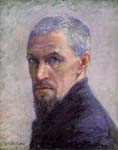Gustave Caillebotte

Gustave Caillebotte (19 August 1848 – 21 February 1894) was a French painter, member and patron of the artists known as Impressionists, although he painted in a much more realistic manner than many other artists in the group. Caillebotte was noted for his early interest in photography as an art form.
Gustave Caillebotte was born on 19 August 1848 to an upper-class Parisian family living in the rue du Faubourg-Saint-Denis. His father, Martial Caillebotte (1799–1874), was the inheritor of the family's military textile business and was also a judge at the Seine department's Tribunal de commerce. Caillebotte's father was twice widowed before marrying Caillebotte's mother, Céleste Daufresne (1819–1878), who had two more sons after Gustave, René (1851–1876) and Martial (1853–1910). Caillebotte was born at home on rue du Faubourg-Saint-Denis in Paris, and lived there until 1866 when his father had a home built on rue de Miromesnil. Beginning in 1860, the Caillebotte family began spending many of their summers in Yerres, a town on the Yerres River about 12 miles (20 km) south of Paris, where Martial Caillebotte, Sr. had purchased a large property. It probably was around this time that Caillebotte began to draw and paint.
Caillebotte earned a law degree in 1868, a licence to practise law in 1870, and he also was an engineer. Shortly after his education, he was drafted to fight in the Franco-Prussian war, and served from July 1870 to March 1871 in the Garde Nationale Mobile de la Seine.
After the war, Caillebotte began visiting the studio of painter Léon Bonnat, where he began to study painting seriously. He developed an accomplished style in a relatively short period of time and had his first studio in his parents' home. In 1873, Caillebotte entered the École des Beaux-Arts, but apparently did not spend much time there. He inherited his father's fortune in 1874 and the remaining sons divided the family fortune after their mother's death in 1878. Around 1874, Caillebotte met and befriended several artists working outside the official French Academy, including Edgar Degas and Giuseppe de Nittis, and he attended (but did not participate in) the first Impressionist exhibition of 1874.
Caillebotte's painting career slowed dramatically in the early 1890s, when he stopped making large canvases. Caillebotte died of pulmonary congestion while working in his garden at Petit-Gennevilliers in 1894 at age 45. He was interred at Père Lachaise Cemetery in Paris.
For many years and in part because he never had to sell his work to support himself, Caillebotte's reputation as a painter was overshadowed by his recognition as a supporter of the arts. Seventy years after his death, however, art historians began reevaluating his artistic contributions. His striking use of varying perspective is particularly admirable and sets him apart from his peers who may have exceeded him in other artistic areas. His art was largely forgotten until the 1950s when his descendents began to sell the family collection. In 1964, The Art Institute of Chicago acquired Paris Street; Rainy Day, spurring American interest in the artist. By the 1970s, his works were being exhibited again and critically reassessed.
The National Gallery of Art (Washington, D.C.) and the Kimbell Art Museum (Fort Worth, Texas) organized a major retrospective display of Caillebotte's painting, for exhibition in 2015–2016, to pursue further the rediscovery of his work.
From Wikipedia, the free encyclopedia
